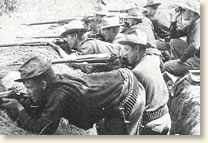|

American troops engage Filipinos during
the Philippine Insurrection, 1899
|
America's war with Spain lasted only a few months during the spring and summer of 1898. At a cost of approximately 400 dead or wounded, the United States acquired the former Spanish possessions of Puerto Rico, Guam and the Philippines. America emerged as a world power with a presence in the Asiatic Pacific. For Spain it was a humiliating defeat. Both her Atlantic and Pacific fleets were sent to the bottom of the sea. With the sinking fleets went Spain's prestige as a world power. Theodore Roosevelt described the conflict as "a splendid little war."
America's acquisition of the Philippines came almost as an afterthought and as a result of broken communications between Washington and U.S. forces fighting on the islands. In preparation for the attack on Manila, the Americans cut the underwater cable connecting the capital city with Hong Kong. The successful storming of the city took place on August 13. But because of the disrupted communications, the commanders on both sides were unaware that an armistice had been signed between Spain and the U.S. the previous day.
The war with Spain may have been "splendid" for the United States, but its aftermath soon turned into a nightmare. The leaders of the Filipino nationalistic movement, who had been battling a long campaign for independence, where no more ready to accept American domination than they were that of the Spanish. Fighting broke out on February 4, 1899, when nationalist forces under the command of Emilio Aguinaldo fired on an American outpost near Manila. Over the next several days American troops forced the insurgents out of the city and into the countryside. Fighting continued for three years. The nationalists resorted to guerrilla tactics effectively using surprise attacks and their superior knowledge of the jungle. The Americans drew upon their long experience in fighting the western Indians for counter tactics. In many ways, the Insurrection was a harbinger of America's experience in Vietnam 65 years later.
In March 1901 Aguinaldo was captured through a ruse concocted by General Frederick Funston, commander of U.S. forces. Despite the capture of their leader, the insurgents continued to battle. It was not until July 4, 1902 that President Roosevelt was able to declare the conflict officially over.
Major Frank Anders received the Congressional Medal of Honor for his actions during the conflict. In a 1931 radio broadcast he recalled his experience during a surprise attack by the Insurgents.
References: Chidsey, Donald B., Spanish American War (1971); Freidel, Frank, The Splendid Little War (1958).
|






